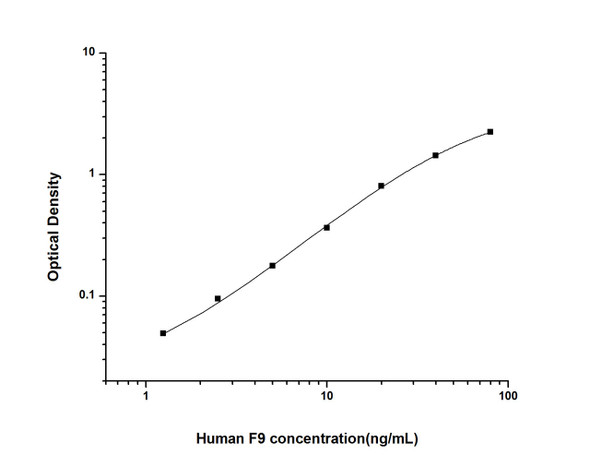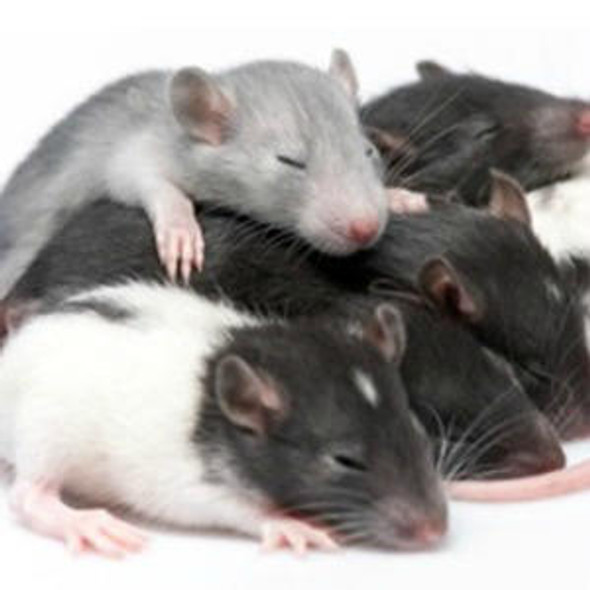Human Cardiovascular ELISA Kits
Human F9 (Coagulation Factor IX) CLIA Kit (HUES00476)
- SKU:
- HUES00476
- Product Type:
- ELISA Kit
- ELISA Type:
- CLIA Kit
- Size:
- 96 Assays
- Sensitivity:
- 0.19ng/mL
- Range:
- 0.31-20ng/mL
- ELISA Type:
- Sandwich
- Synonyms:
- HEMB, P19, PTC, THPH8, Christmas Factor
- Reactivity:
- Human
- Sample Type:
- Serum, plasma and other biological fluids
- Research Area:
- Cardiovascular
Description
| Assay type: | Sandwich |
| Format: | 96T |
| Assay time: | 4.5h |
| Reactivity: | Human |
| Detection method: | Chemiluminescence |
| Detection range: | 0.31-20 ng/mL |
| Sensitivity: | 0.19 ng/mL |
| Sample volume: | 100µL |
| Sample type: | Serum, plasma and other biological fluids |
| Repeatability: | CV < 15% |
| Specificity: | This kit recognizes Human F9 in samples. No significant cross-reactivity or interference between Human F9 and analogues was observed. |
This kit uses Sandwich-CLIA as the method. The micro CLIA plate provided in this kit has been pre-coated with an antibody specific to Human F9. Standards or samples are added to the appropriate micro CLIA plate wells and combined with the specific antibody. Then a biotinylated detection antibody specific for Human F9 and Avidin-Horseradish Peroxidase (HRP) conjugate are added to each micro plate well successively and incubated. Free components are washed away. The substrate solution is added to each well. Only those wells that contain Human F9, biotinylated detection antibody and Avidin-HRP conjugate will appear fluorescence. The Relative light unit (RLU) value is measured spectrophotometrically by the Chemiluminescence immunoassay analyzer. The RLU value is positively associated with the concentration of Human F9. The concentration of Human F9 in the samples can be calculated by comparing the RLU of the samples to the standard curve.
| UniProt Protein Function: | F9: Factor IX is a vitamin K-dependent plasma protein that participates in the intrinsic pathway of blood coagulation by converting factor X to its active form in the presence of Ca(2+) ions, phospholipids, and factor VIIIa. Defects in F9 are the cause of recessive X-linked hemophilia B (HEMB); also known as Christmas disease. Mutations in position 43 (Oxford-3, San Dimas) and 46 (Cambridge) prevents cleavage of the propeptide, mutation in position 93 (Alabama) probably fails to bind to cell membranes, mutation in position 191 (Chapel-Hill) or in position 226 (Nagoya OR Hilo) prevent cleavage of the activation peptide. Defects in F9 are the cause of thrombophilia due to factor IX defect (THPH8). A hemostatic disorder characterized by a tendency to thrombosis. Belongs to the peptidase S1 family. |
| UniProt Protein Details: | Protein type:Secreted; Protease; EC 3. 4. 21. 22; Secreted, signal peptide Chromosomal Location of Human Ortholog: Xq27. 1-q27. 2 Cellular Component: Golgi lumen; endoplasmic reticulum lumen; extracellular region; plasma membrane Molecular Function:serine-type endopeptidase activity; calcium ion binding Biological Process: blood coagulation, extrinsic pathway; cellular protein metabolic process; blood coagulation; post-translational protein modification; proteolysis; blood coagulation, intrinsic pathway; peptidyl-glutamic acid carboxylation Disease: Hemophilia B; Thrombophilia, X-linked, Due To Factor Ix Defect; Coumarin Resistance |
| NCBI Summary: | This gene encodes vitamin K-dependent coagulation factor IX that circulates in the blood as an inactive zymogen. This factor is converted to an active form by factor XIa, which excises the activation peptide and thus generates a heavy chain and a light chain held together by one or more disulfide bonds. The role of this activated factor IX in the blood coagulation cascade is to activate factor X to its active form through interactions with Ca+2 ions, membrane phospholipids, and factor VIII. Alterations of this gene, including point mutations, insertions and deletions, cause factor IX deficiency, which is a recessive X-linked disorder, also called hemophilia B or Christmas disease. [provided by RefSeq, Jul 2008] |
| UniProt Code: | P00740 |
| NCBI GenInfo Identifier: | 67476446 |
| NCBI Gene ID: | 2158 |
| NCBI Accession: | P00740. 2 |
| UniProt Secondary Accession: | P00740,Q5FBE1, Q5JYJ8, A8K9N4, F2RM36, |
| UniProt Related Accession: | P00740 |
| Molecular Weight: | 461 |
| NCBI Full Name: | Coagulation factor IX |
| NCBI Synonym Full Names: | coagulation factor IX |
| NCBI Official Symbol: | F9 |
| NCBI Official Synonym Symbols: | FIX; P19; PTC; HEMB; THPH8 |
| NCBI Protein Information: | coagulation factor IX; F9 p22; FIX F9; factor 9; factor IX F9; Christmas factor; plasma thromboplastic component; plasma thromboplastin component |
| UniProt Protein Name: | Coagulation factor IX |
| UniProt Synonym Protein Names: | Christmas factor; Plasma thromboplastin component; PTC |
| Protein Family: | F9 protein |
| UniProt Gene Name: | F9 |
| UniProt Entry Name: | FA9_HUMAN |
As the RLU values of the standard curve may vary according to the conditions of the actual assay performance (e. g. operator, pipetting technique, washing technique or temperature effects), the operator should establish a standard curve for each test. Typical standard curve and data is provided below for reference only.
| Concentration (ng/mL) | RLU | Average | Corrected |
| 20 | 32135 35829 | 33982 | 33950 |
| 10 | 12400 12540 | 12470 | 12438 |
| 5 | 5404 5096 | 5250 | 5218 |
| 2.5 | 2521 2527 | 2524 | 2492 |
| 1.25 | 1426 1340 | 1383 | 1351 |
| 0.63 | 935 799 | 867 | 835 |
| 0.31 | 620 626 | 623 | 591 |
| 0 | 31 33 | 32 | -- |
Precision
Intra-assay Precision (Precision within an assay): 3 samples with low, mid range and high level Human F9 were tested 20 times on one plate, respectively.
Inter-assay Precision (Precision between assays): 3 samples with low, mid range and high level Human F9 were tested on 3 different plates, 20 replicates in each plate.
| Intra-assay Precision | Inter-assay Precision | |||||
| Sample | 1 | 2 | 3 | 1 | 2 | 3 |
| n | 20 | 20 | 20 | 20 | 20 | 20 |
| Mean (ng/mL) | 0.96 | 1.99 | 8.48 | 0.97 | 2.09 | 8.92 |
| Standard deviation | 0.11 | 0.20 | 0.68 | 0.11 | 0.18 | 1.01 |
| C V (%) | 11.46 | 10.05 | 8.02 | 11.34 | 8.61 | 11.32 |
Recovery
The recovery of Human F9 spiked at three different levels in samples throughout the range of the assay was evaluated in various matrices.
| Sample Type | Range (%) | Average Recovery (%) |
| Serum (n=5) | 93-107 | 99 |
| EDTA plasma (n=5) | 84-98 | 91 |
| Cell culture media (n=5) | 93-109 | 99 |
Linearity
Samples were spiked with high concentrations of Human F9 and diluted with Reference Standard & Sample Diluent to produce samples with values within the range of the assay.
| Serum (n=5) | EDTA plasma (n=5) | Cell culture media (n=5) | ||
| 1:2 | Range (%) | 98-112 | 99-113 | 88-102 |
| Average (%) | 103 | 106 | 93 | |
| 1:4 | Range (%) | 89-104 | 86-97 | 91-103 |
| Average (%) | 95 | 91 | 97 | |
| 1:8 | Range (%) | 99-118 | 90-101 | 93-105 |
| Average (%) | 108 | 96 | 99 | |
| 1:16 | Range (%) | 85-98 | 89-102 | 100-112 |
| Average (%) | 92 | 94 | 106 |
An unopened kit can be stored at 4°C for 1 month. If the kit is not used within 1 month, store the items separately according to the following conditions once the kit is received.
| Item | Specifications | Storage |
| Micro CLIA Plate(Dismountable) | 8 wells ×12 strips | -20°C, 6 months |
| Reference Standard | 2 vials | |
| Concentrated Biotinylated Detection Ab (100×) | 1 vial, 120 µL | |
| Concentrated HRP Conjugate (100×) | 1 vial, 120 µL | -20°C(shading light), 6 months |
| Reference Standard & Sample Diluent | 1 vial, 20 mL | 4°C, 6 months |
| Biotinylated Detection Ab Diluent | 1 vial, 14 mL | |
| HRP Conjugate Diluent | 1 vial, 14 mL | |
| Concentrated Wash Buffer (25×) | 1 vial, 30 mL | |
| Substrate Reagent A | 1 vial, 5 mL | 4°C (shading light) |
| Substrate Reagent B | 1 vial, 5 mL | 4°C (shading light) |
| Plate Sealer | 5 pieces | |
| Product Description | 1 copy | |
| Certificate of Analysis | 1 copy |
- Set standard, test sample and control (zero) wells on the pre-coated plate and record theirpositions. It is recommended to measure each standard and sample in duplicate. Note: addall solutions to the bottom of the plate wells while avoiding contact with the well walls. Ensuresolutions do not foam when adding to the wells.
- Aliquot 100µl of standard solutions into the standard wells.
- Add 100µl of Sample / Standard dilution buffer into the control (zero) well.
- Add 100µl of properly diluted sample (serum, plasma, tissue homogenates and otherbiological fluids. ) into test sample wells.
- Cover the plate with the sealer provided in the kit and incubate for 90 min at 37°C.
- Aspirate the liquid from each well, do not wash. Immediately add 100µL of BiotinylatedDetection Ab working solution to each well. Cover the plate with a plate seal and gently mix. Incubate for 1 hour at 37°C.
- Aspirate or decant the solution from the plate and add 350µL of wash buffer to each welland incubate for 1-2 minutes at room temperature. Aspirate the solution from each well andclap the plate on absorbent filter paper to dry. Repeat this process 3 times. Note: a microplatewasher can be used in this step and other wash steps.
- Add 100µL of HRP Conjugate working solution to each well. Cover with a plate seal andincubate for 30 min at 37°C.
- Aspirate or decant the solution from each well. Repeat the wash process for five times asconducted in step 7.
- Add 100µL of Substrate mixture solution to each well. Cover with a new plate seal andincubate for no more than 5 min at 37°C. Protect the plate from light.
- Determine the RLU value of each well immediately.






